Paints: AK modulations sets: Vallejo Model Air/Color
Weathering: Vallejo acrylic washes, Iwata Com-Art paints; AK enamel streaking grime
Base & Foliage: Scenic Express Super Trees (European equivalent “Sea Moss”), several colors and textures of flock from Noch, Woodland Scenic and Scenic Express




The Vehicle:
I'd like to give a brief biography of the vehicle I had in mind. The JagdPanzer IV was developed in reaction to the T-34 shock of 1941-42. It was the first tank destroyer designed from the ground up for the task – the much lighter Hetzer was started later but delivered a little sooner. Stugs, Marders etc, although often successful, were all hybrids and carried some ugly baggage. The JP was based on the PKIV chassis but given very strong sloped armor and after Normandy armed with the same gun carried by the Panther. A very successful design, although only 2,000 were built because the Germans did a poor job of getting a prototype out the door quickly especially with allied bombing gumming up the works. The big Panther gun made it front heavy (the vehicle was only about 25 tons) and its crewmen often called it “Guderian's Duck”. Badly named actually – Guderian saw the need for Stugs and Hetzers – but wanted heavier AFVs to have turrets. The German Army put great emphasis on counterattack and this was one role the JPIV was not good at – the gun's traverse was poor and in a “battle of encounter” (very frequent) it was at a serious disadvantage against any true tank. Any Soviet tank and 76mm Shermans could penetrate the JP side armor inside the 500 yards or so that these violent clashes often took place. In such battles you wanted a turret and Guderian kept the standard PZIV in production until the bitter end despite Hitler's orders to use all PZIV production for JPs.
Probably 2/3ds of the Jagdpanzers went East where counterattacks were increasingly rare and the need for a reliable vehicle with whopping big gun obvious. But early models JP served at Normandy (most carrying the standard PZIV 75mm). About a hundred of the up gunned “Lang” variants were at the Ardennes. Production continued and some went to Nordwind. After January 45 the Wehrmacht was ordered to make the allies bleed for every mile on the advance to the Rhine. Hence a good supply tank destroyers (which in allied terms was a tiny supply) was kept or sent West where they tried to reproduce the effective delay tactics employed employed between October and December 44. Ideally tank destroyers would work with VolkGrenadiers (the surprisingly effective sweeping of the manpower barrel managed by Himmler and Goebbels starting in September 44 allowing the raising for 40 divisions equivalent of units that varied greatly in quality) or the last gasp Volkstrum. So figure the great power of a rare state of the art AFV like a Panther or JP working in concert with a blizzard of erratic infantry armed superb small arms and mgs plus deadly PanzerFaust and PanzerSchrect. Manpower quality was down greatly, but if the situation was ugly and the officers were good, they could still inflict painful casualties on their enemies. (American casualties in each month of 1945 -including April- rivaled the worst of 44.) So I'm thinking of a Jagdpanzer in an ambush position sometime in early March on either side of the Rhine. There was little city fighting in the Western allies' attack on Germany, so most fighting was comprised of a large number of small ugly engagements. The terrain would have been wooded if not forest with soil still soft. Rather like the Ardennes after the thaw. Many hills, small villages, crossroads of minor roads. Last project I put a US M8 in the snow and mud of late January and the upcoming JS2 will get the heavy mud treatment too, so I wanted something different. Think of this tank as having arrived for the Ardennes and survived. In March 45 a vehicle like this would be waiting in ambush and its crew hoping for the best.
The Kit:
This kit is a new tool effort from Tamiya less than a year off the presses. It is a brilliant kit. The part count is about 250 but unlike DML efforts there are zero extras. Personally I find the detail perfectly adequate particularly knowing how badly I was going to mangle it. There are three sets of PE – Tamiya makes a new gun with metal barrel if you want a gun that moves like the real one: plastic barrel was one piece and because there really is no place to see an interior I saw no reason to create one. There are side skirts available, but that would have hid the elaborate lower hull and from the pics I could track down full schurzen were rarely used – it also made the beast look very clumsy. The third was largely detail stuff for tools etc – stuff that bores me to tears and would also be invisible. Instead I installed a lot of stowage and a lot of foliage. Like 8th grade art class – great fun really.
The engineering was nearly faultless. Pieces are in perfect numerical order on the sprues. The plastic is of perfect consistency – not too brittle or too soft. The small parts were always placed on the sprues to make them easy to remove with little danger to the part or residue. The instructions always showed, usually on the next step, how the parts were to look when installed. (Listening DML? I've never made one without installing a part incorrectly simply because it was never shown clearly how it was to lay.) All of the major parts fit so well that filler was left on the shelf. A full interior would have been nice but the way the JPIV was designed there was no way to show it off, so I buttoned up the buggy. The very well detailed plastic tracks were so precise that I glued them before assembly and the brass pieces gave, if anything, too much sag. Because of the vehicles design there were buckets of road wheels. I like them a lot. Road wheels are Zen modeling: you can go through the pleasingly repetitive task and listen to Bach at the same time. Below is the assembly up to prime:


Here it is with black/gray Vallejo primer on it - I always apply this in a fine coat. There will be a lot more coming.

Painting:
The Tamiya instructions and many of the pics of the new kit appearing made by good modelers (very small number of original wartime photos for some reason) showed a classic three color 1944 scheme. Might have been right for the Normandy or the Bulge, but there was no one recipe. As always I've burned a lot of time looking at photos to prove what I already knew: the German "three color" camo scheme appeared in a few thousand variations.
This might be almost literally true. According to Terence Wise in the classic Squadron book "D-Day to Berlin" German tank crews were given pots of olive green and red brown paste to dilute as they saw please-with petrol or water and apply to the Dunkelgelb factory applied base. Apparently some German AFVS were given factory applied the "ambush scheme" for a few months in 44. AFVs used to delay the allied avalanche toward the Rhine were certainly given them: Hetzers and Jagdpanzers were often decked that way. But not for long in the case of JP. Orderly production was breaking down. In addition, the paint job was essentially a field modification made by the crew, I'd guess that if a vehicle stayed in action for any amount of time it may have worn several different schemes. The kind of classic three color scheme with large green and brown hard edged (sort of hard - if you look close you can see a little fuzz on almost every one of them - about what you'd expect from hand painted or hand airbrushed vehicle.) More likely you'd see Dunkelgelb dominant with large blotches of green and smaller bits of brown. (Depending upon dilution - Olive green can range from a very dark color to a very light pea green: the brown from dark to almost a rust-like very light tone.) The various combinations defied generalization near the end of the war.
I chose a Dunkelgelb with a good dose of dark olive green and only light blotches of brown-red. I had AK “modulation sets”for both DG and the Olive/Brauns. Perhaps I had bad luck but I was very disappointed with both. Two bottles were spoiled before opening. The paint was unusually coarse – making for some clogged tips – and some of the browns & greens looked off to me. I used Vallejo Model Color for the green and Model Air for the Rotbraun – much better. (All hand work in DG was from Model Color “Middlestone” - a perfect match.)
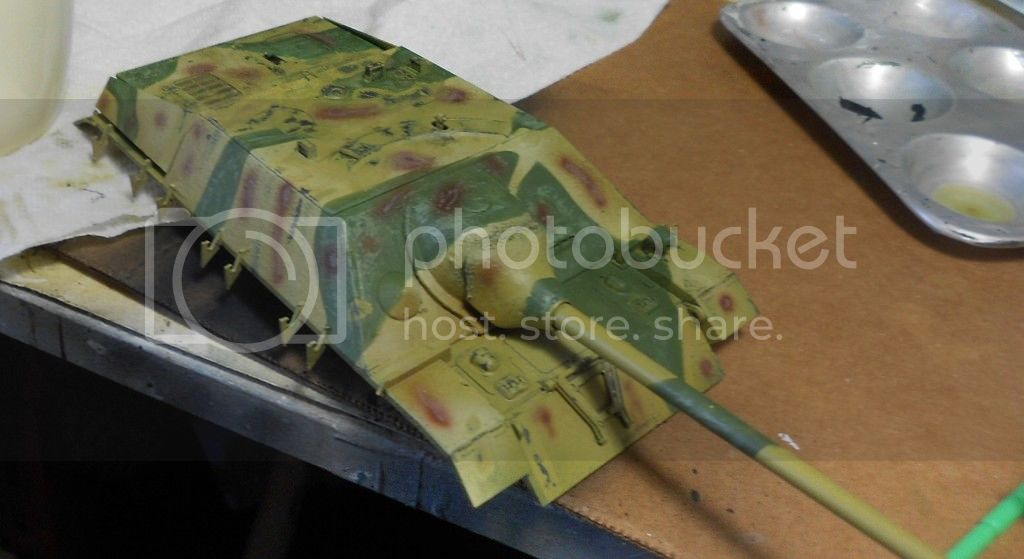
Next I used a technique to show wear that I got from Mike Rinaldi the wonderful modeler and author of the “Tank Art” series that he calls “reverse dry brushing.” The idea is to have a dark color (I used lacquer protected Vallejo black/gray primer) with a lighter color on top (I'm aware that German armor used a rusty red primer - but I'm not trying to emulate a stain that went to the primer or steel). When dry, dampen a stiff brush with something like Vallejo airbrush cleaner, ISP or Tamiya lacquer thinner. The less time it takes to dry, the faster and easier a bit will come off. What is left are areas that are more like a surface marred by boots and grime ground in on or around areas where the crew would be very active.

After this came three filter Com.Art and undiluted an Vallejo acrylic sepia pin wash. (Because both products are quite forgiving I dickered with both several times – I did keep the kit gloss for filters and matte for pin washes – Vallejo has fine mediums for both. I was thinking of a tank that had survived the Ardennes and the intense fighting west of the Rhine, so I gave it more chipping than normal. I do like the AK streaking grime and I applied some.
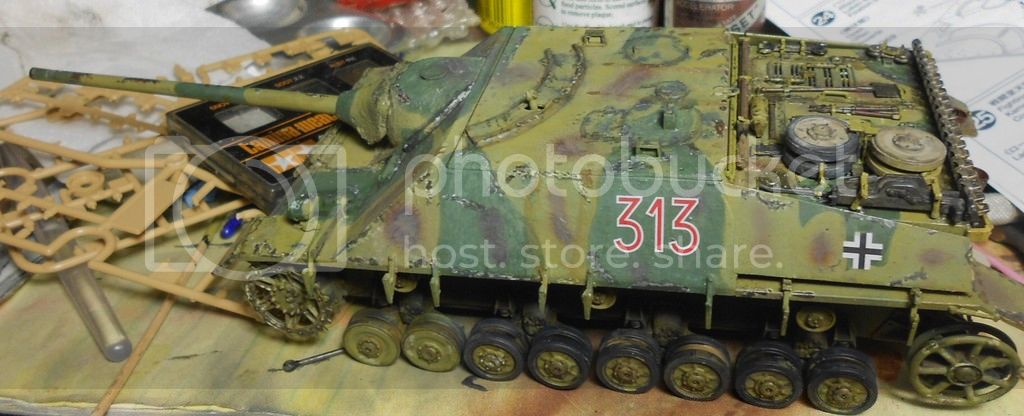
Stowage and Foliage:
There isn't a lot visual interest in the JPIV – it's got a face only a mother could love and a lot of simple surfaces. The rear however has lots of tools. I though I did them up right and wanted to leave them on. Unfortunately, almost every film and a lot pics of JPs showed a vehicle with a lot of stowage. History won and I put on some equipment from Academy and big piece of netting from my shash. So here's what it looked like weighted down:
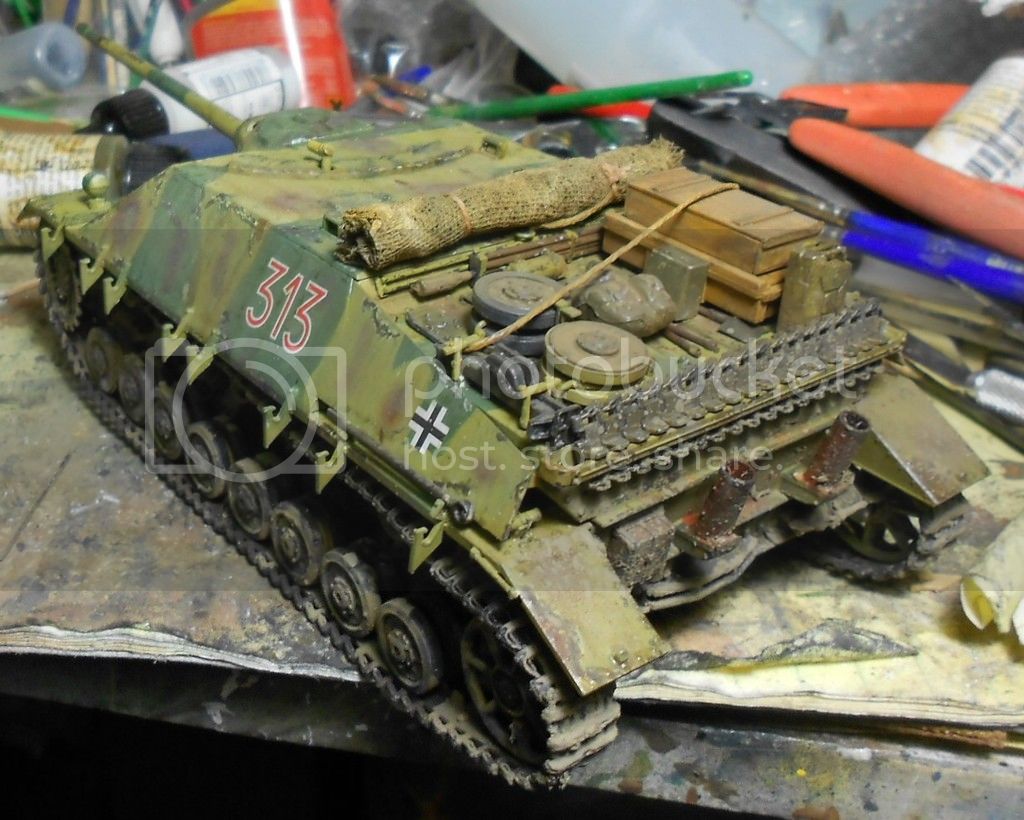
I spent a lot of times with pigments. I use artist pigments from Sennelier and the fine US brand Gamblin. They're better than anything on the market (the differences are not great) and are much cheaper for ounce. I put on several colors of dry mud under the hull and a couple of layers of heavier soft dirt or dry mud. I used some Pledge to moisten some areas and added a good dose of graphite on the front and sides. After a little dickering that was pretty much that. Here are a few pics before we the base and foliage were applied.


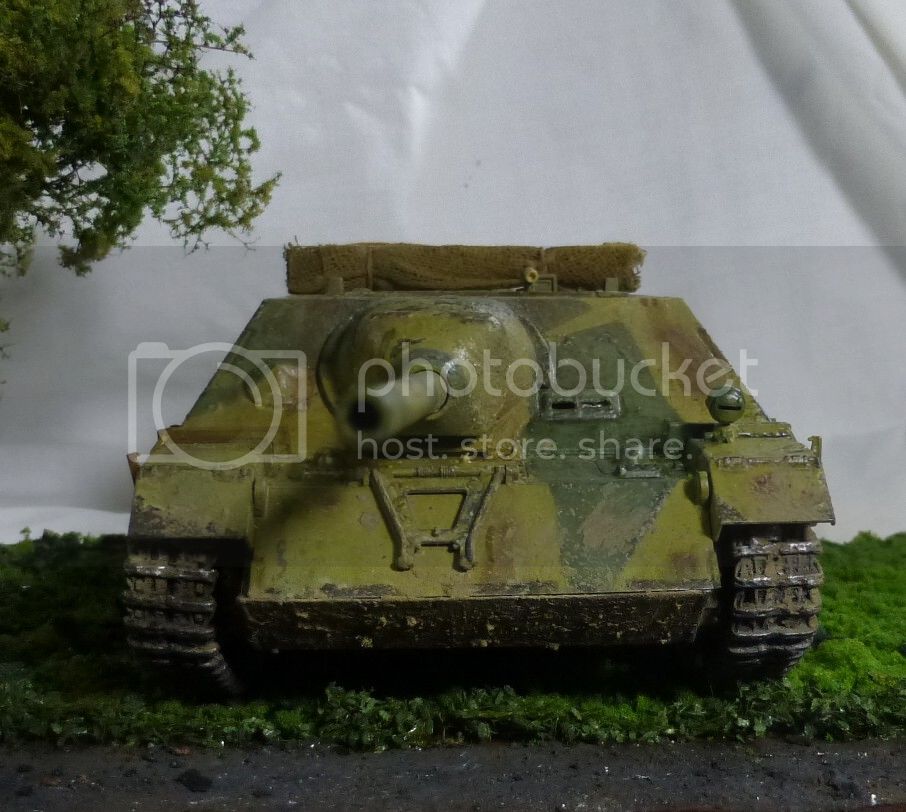
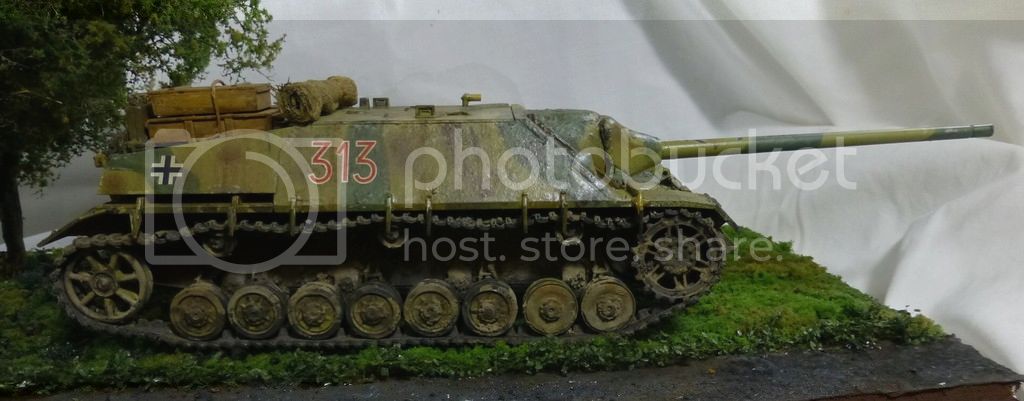
A fair build in my standards but I couldn't leave well enough alone. But the most cursory look of German AFVs in late war show them covered with foliage. (Allied vehicles were similar.) So that meant making some foliage for the JP and, just to make life complicated I made a base.
The stuff I used for the foliage and base was a combination of materials obtained from a Model Railroad's company “Scenic Express.” The major product is what SE calls “Super Trees.” This item is made up of dried Norwegian arctic shrubbery. It's not cheap ($35 for a basic package) but includes enough of the stuff to keep a couple generations of tank modelers happy. It's well packaged because if the stuff gets wet, a mold can form and ruin the lot. I've only begun to explore Railroaders techniques and think they offer much. Super Trees, for instance, have a look that makes plastic or wire armatures toy-like. Most of the stuff is aimed at large dios for railroads and most of the clumps are designed to be turned directly into trees with artificial “flock” (very small bits of plastic that could stand in for grass or leaves depending on the scale.) The flock is an art into itself and I've only got four colors and need at least five more. However for a project in 1/35 scale standard Super Trees make terrific shrubs, bushes and camo foliage. However if I simply used a tree shaped piece it would look like a 12' high tree with a trunk as thick as my wrist. Fortunately they include a bag of the plant's major branches and when dried they are much larger. They're utterly bare so to build a big tree like I did (could only eyeball – the JP was 6' high – I'd guess the tree at 18'. What you have to do is employ large numbers of the smaller branch, glue them to the big branches and then apply the flock. All branches on the tree were painted gray with some black flecks. (As one of the RR gurus on YouTube put it, “trees are not brown.” I've looked at a lot of trees in the last couple of weeks and he's right there.) You attach the flock with a brushed or sprayed on “Matte Medium” which is sold cheap by SE. A blast of hairspray will lock the flock on nicely. Here's the junk below: the spindly stuff is the bulk of the Super Tree collection – there is one of the thick branches there, a pack of very good flock from a German company Noch, and a few regular super trees treated by yours truly with flock.
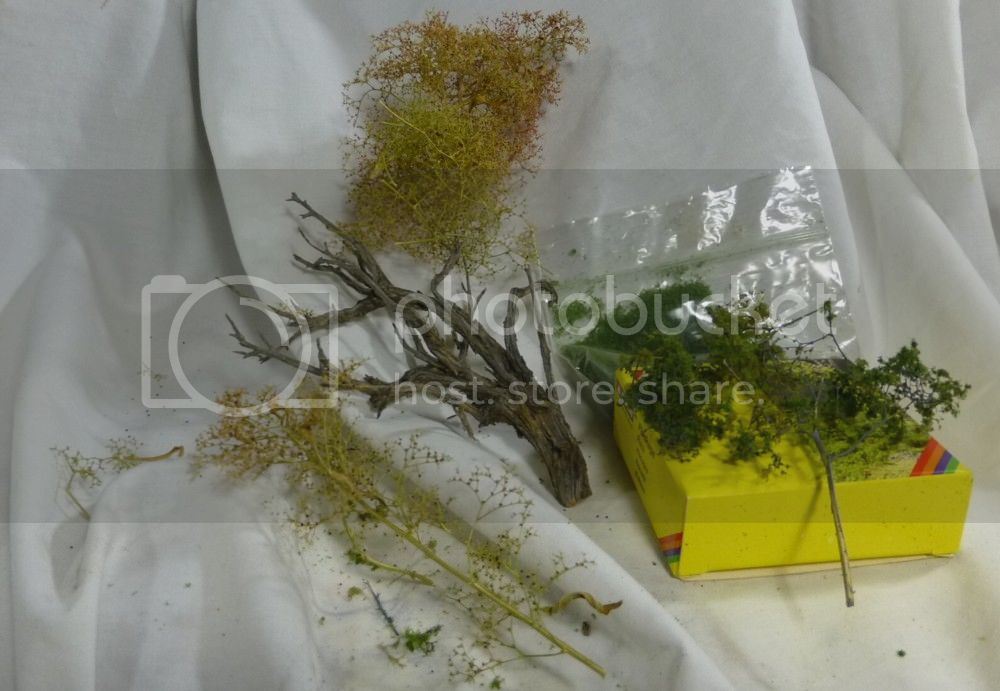
Here are a couple of pics showing the JP with it's own foliage. German AFVs did have tank netting but most crews found it miserable to use and thus welded a few loops onto the hull to help anchor some some proper camo if they were setting up a defensive position. The camo itself was often replaced daily and tidied up if it looked like the Earp Brothers were coming.

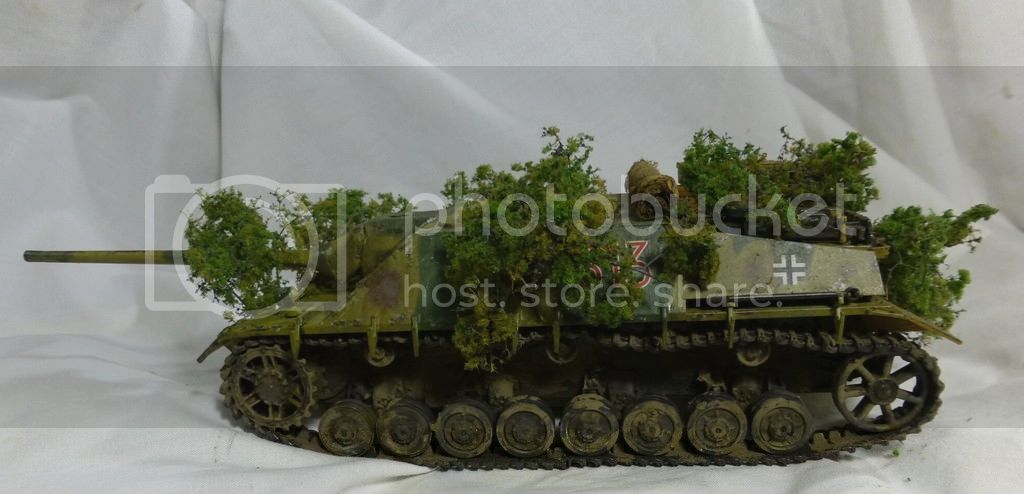

In for a penny, in for a pound. I think it accurate that if possible a Jagdpanzer in harm's way would have been in a camouflaged position. Here's the base I made for it. It's possible to see the darker curved strips made by the tracks moved into position.
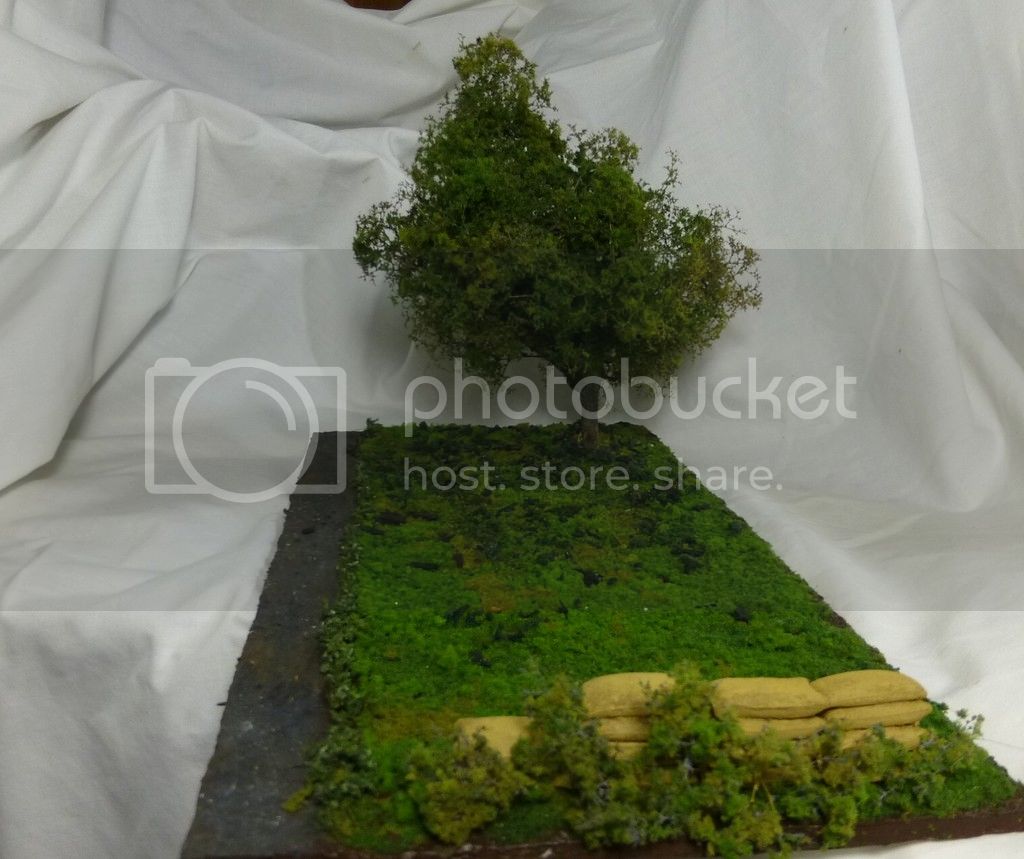
There should have been infantry near so I put in some sand bags could have been quickly manned if the JP had to withdraw. Here is finis:
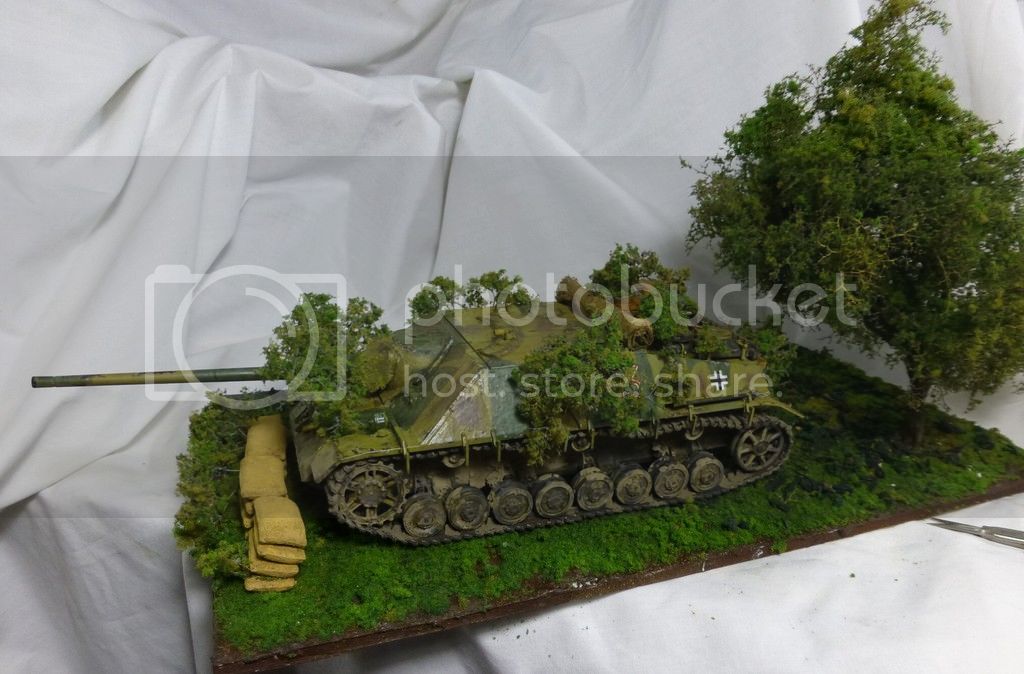
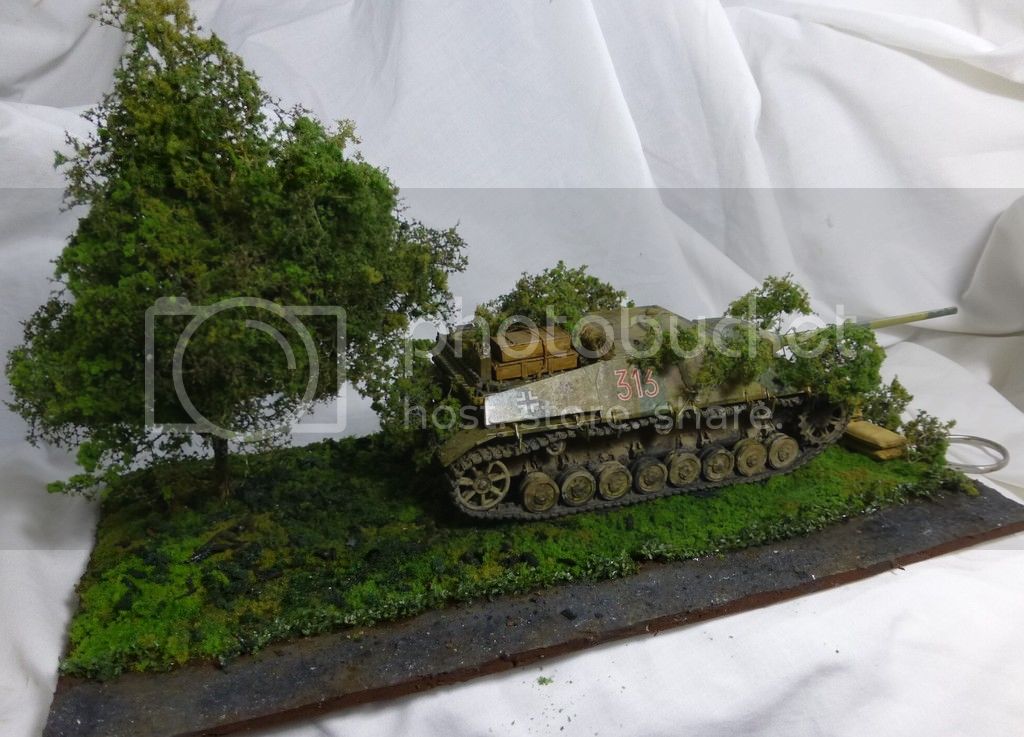

I kind of like this one:

Interested in any comments. I have not mastered armor so every time out I trying something new or extra – almost guarantees some failures. Anyway, interested in what wiser heads think.
Eric









 .
. 









